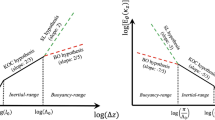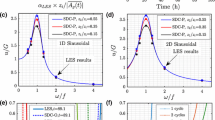Summary
Using the vorticity and the thermodynamic equation, ‘Omega Equation’ has been derived. The effect of friction is not taken into account. The vertical velocity omega (ω) is composed of two parts, viz. mean baroclinicity in the atmosphere and heating. The baroclinicity part includes three terms. The magnitude of the second term is of the order of 10−10 to 10−12 mb−1 sec−2,and that of the last is 10−10 to 10−12 mb−1 sec−2, whereas the first term is of the order of the vertical velocity omega 10−4 to 10−6 sec−1. Therefore, the higher order terms can be omitted. Thus with the above approximation the complicated expression for omega is reduced to a simple form.
Similar content being viewed by others
References
T. Murakami,The mean vertical velocity and heat supply during the rainy season near Japan, papers in Meteor. & Geophys. JapanVIII (1957).
J. Shukla,On the Numerical Solution of Diabatic Quasi-Geostrophic Omega Equation, India Meteorological Dept., Scientific Report No. 80, December 1968.
J. G. Charney,On the scale of atmospheric motion, Geophys. Publ.17 (2) (1948).
Author information
Authors and Affiliations
Rights and permissions
About this article
Cite this article
Singh, U.S., Rathor, H.S. Reduction of the complete omega equation to the simplest form. PAGEOPH 112, 219–223 (1974). https://doi.org/10.1007/BF00875937
Received:
Issue Date:
DOI: https://doi.org/10.1007/BF00875937




